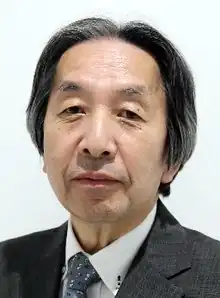Masahiro Hara | |
|---|---|
原 昌宏 | |
 Masahiro Hara | |
| Born | 1957 |
| Nationality | Japanese |
| Alma mater | Hosei University |
| Known for | Inventing the QR code |
| Awards | European Inventor Award |
Masahiro Hara (Japanese: 原 昌宏, Hepburn: Hara Masahiro, born 1957) is a Japanese engineer and Hosei University graduate who is best known for inventing the QR code in 1994.[1][2]
Early life and education
Hara was born in Tokyo in 1957.[3] He studied in the department of electric and electronic engineering at Hosei University.[1][4] He graduated in 1980.[5]
Career

Denso and QR code invention
After graduating from Hosei University, Hara is working at the Japanese company Denso, which is a subsidiary of the Toyota Group. From then on, Hara started working for develop a barcode system.[6] In 1992, in Denso's developing department (later Denso Wave), Hara had given a task to develop a new 2D code system that is capable of productively tracking components used in the automotive industry, thus started a new project.[7][8][9][10] One day at work, over a lunchtime game of go, he recognized the game's black and white pattern could be used to encode information.[6] He also made an investigation on publications to seek a unique proportion for the position pattern to make sure that readers could be able to identify.[11] The code was introduced in 1994.[12]
In 2021, QR codes were being used to book and track COVID-19 tests and contact tracing.[6] Hara has stated that he would like to develop QR codes for additional medical purposes, including imaging such as x-rays or electrocardiogram data.[2] Hara still works for Denso as of 2022.[1]
Japan International Cooperation Agency
Hara was the chief engineer and advisor for a Japan International Cooperation Agency's "School For All" program to improve education in Niger.[13][14]
Selected publications
Awards
In 2014, he and the inventors of the QR code development team were awarded the European Inventor Award.[17]
References
- 1 2 3 "Meet the Man Who Invented The QR Code". Worldcrunch. 2022-01-24. Retrieved 2022-01-30.
- 1 2 Oba, Yumi (19 November 2021). "'Father of QR code' says the technology's future is in storing important medical information". SBS Japanese. Retrieved 2 February 2022.
- ↑ "TEDxAnjo | TED". www.ted.com. Retrieved 2022-04-10.
- ↑ Hara, Masahiro (2019). "Development and popularization of QR code: —Code development pursuing reading performance and market forming by open strategy—". Synthesiology English Edition. 12 (1): 19–28. doi:10.5571/syntheng.12.1_19. S2CID 203138539.
- ↑ "Members of Faculty Pamphlet" (PDF). Hosei University. p. Cover page.
"Hosei Alumnus, Masahire Hara invented QR code (1994) Denso Cp. Ltd. Graduated from Hosei University in 1980
- 1 2 3 "'I'm pleased it is being used for people's safety': QR code inventor relishes its role in tackling Covid". the Guardian. 2020-12-11.
- ↑ Gapper, John (2020-10-30). "Ant and Covid have made the humble QR code a hit". Financial Times. Retrieved 2022-01-30.
- ↑ "The Little-Known Story of the Birth of the QR Code". nippon.com. 2020-02-10.
- ↑ Boulton, Jim (2014). "The QR Code". 100 Ideas that Changed the Web. Quercus Publishing. ISBN 978-1-78067-642-5.
This all changed in the early '90s at Denso Wave, a subsidiary of Toyota. An engineer called Masahiro Hara was tasked with creating a barcode that could hold more information than the existing format. His solution was the Quick Response (QR) code...
- ↑ Dobrescu, Andra (July 2015). "Implications of QR Codes for the Business Environment". Calitatea. 16 (S3): 166–169. ProQuest 1694670714.
- ↑ "History of QR Code". Denso Wave. Retrieved 2023-04-30.
- ↑ Goodrich, Joanna (13 November 2020). "How a Board Game and Skyscrapers Inspired the Development of the QR Code". IEEE Spectrum: Technology, Engineering, and Science News.
- ↑ Kharas, Homi J.; Linn, Johannes F. (2013). Getting to Scale: How to Bring Development Solutions to Millions of Poor People. Brookings Institution Press. pp. 296, 300. ISBN 978-0-8157-2419-3.
- ↑ "JICA Experts, Back in Japan, Are Granted an Audience with Their Imperial Highnesses Prince and Princess Akishino, Princess Mako and Princess Kako" (Press release). Japan International Cooperation Agency. 1 October 2018.
- ↑ "Community Participation with Schools in Developing Countries: Towards Equitable and Inclusive Basic Education for All". Routledge & CRC Press. Retrieved 2022-03-20.
- ↑ Maruyama, Takao; Kurosaki, Takashi (December 2021). "Do remedial activities using math workbooks improve student learning? Empirical evidence from scaled-up interventions in Niger". World Development. 148: 105659. doi:10.1016/j.worlddev.2021.105659. S2CID 239705164.
- ↑ Office, European Patent. "Masahiro Hara, Motoaki Watabe, Tadao Nojiri, Takayuki Nagaya, Yuji Uchiyama (Japan)". www.epo.org.
Further reading
- "QR Code 2.0 | Japanese engineer Masahiro Hara says new design will have increased colour & information storage". CNBC TV18. 27 January 2023.